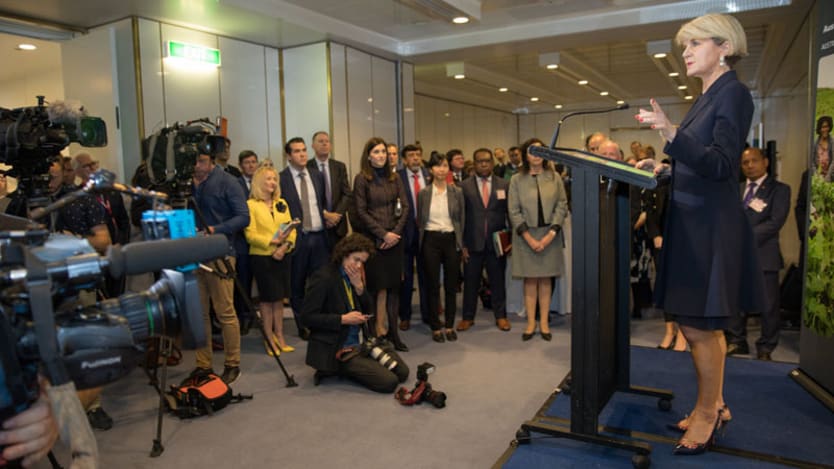
CANBERRA — It has been over three years since innovationXchange, or iXc, was first launched by Australia’s Foreign Minister Julie Bishop as an opportunity for government to learn from the private sector in applying innovation “to deliver efficiency, a better quality of life, productive growth, and positive change.” Even its office design mimicked that of Google, Twitter, and Facebook, aimed at inspiring creativity and encouraging off-the-street engagement from individuals and organizations with an ideas of how to better innovate within the aid program of the Department of Foreign Affairs and Trade.
In the intervening years, the group has received funding from Bloomberg’s Data for Health initiative, partnered with organizations like Google, and piloted new approaches to development challenges ranging from dengue to urban sprawl.
But the question on many minds now is whether such programs, and iXc itself, can become sustainable.
Today, iXc is entering an operational phase that, according to new research from The Policy Lab, poses a challenge to many innovation labs — transitioning from early innovation to building organization-wide change and sustainability into programs.
See more stories:
► How BagoSphere is navigating the funding world — and succeeding
► Politics and development: Insights from dialogues in Canberra
This new phase of development comes as iXc released a new Innovation Strategy earlier this month, providing a roadmap for the next three years. Under the leadership of Chief Innovation Officer Sarah Pearson, a newly created role within DFAT, iXc’s focus will be on building innovative thinking across all of DFAT’s divisions and programs. Leadership, culture, and capability, scaling innovation as well as evaluating, benchmarking, and sharing lessons learnt are the four key focal areas from now until 2021.
It is an important step as iXc remains a unit of contention within DFAT. Shadow Foreign Minister Penny Wong is a chief critic, suggesting it is too separate from aid program’s operations and too focused on “beanbags and celebrities.”
Establishing organization-wide transformation can help negate such criticism.
Australian aid will still remain an important element of the operation of iXc, responsible for managing $50 million Australian dollars ($37 million) in aid dollars and a new government inquiry into effectiveness and outcomes of Australian aid in the Indo-Pacific including a key line of questioning on innovation and specifically iXc.
The focus for the aid program moving forward, however, will be in encouraging program managers to think of innovation and engage iXc early in the development of programs — as well as looking for new caretakers of programs that have been developed through innovation challenges.
The road forward for iXc
As part of Innovation Month in Australia, iXc participated in a public forum of Canberra-based government labs on July 20 to share success stories and enable greater collaboration across the public sector. Speaking with Devex, iXc staff Megan Frail and Nicole Steinweg discussed the roadmap moving forward — and the challenges that still remain to ensure Australia’s aid program can truly be considered innovative.
The work of iXc will be two pronged, they explained, with both sides at different stages of development.
“Our strategy, on the internal side, we are very much at the beginning,” Frail explained to Devex. “As far as our aid and development programs are concerned, we are getting past that pilot stage and moving to the next stage.”
In developing and implementing an internal strategy for fostering innovative thinking and action across all operations, DFAT can learn from other Australian government agencies, Frail believes.
One such area that may provide opportunities is a new training program from the Department of Industry, Innovation and Science that aims to encourage government agencies to use human-centered design and agile approaches in developing all policies and program — not just those with a technology focus.
“We have had a little bit to do with them and they are just starting to get things up and running,” Frail said. “And hopefully they will be engaging with other agencies. We are keen to see what comes out of it and how we can get involved in it.”
Through Australia’s Public Sector Innovation Network, iXc has the opportunity to engage with other government innovation labs to keep abreast with what is happening.
“It is a very corporate facing part of our strategy that wasn’t part of our strategy for the past couple of years as we were busy focusing on the programming side of the program,” Steinweg told Devex. “But in our second round, we are focusing on innovation across the department and all areas including policy, trade — there are much more lessons around here for us to learn on that front.”
This is an area iXc needs to improve in, said Frail. Though three internally focused idea challenges have been held, there are still DFAT staff who are unaware of the purpose and function of iXc.
Outside of the aid program, early public hearings as part of the effectiveness of aid in the Indo-Pacific inquiry have highlighted that this awareness divide also exists externally.
In a public hearing held in Sydney on July 2, two representative from the Export Council of Australia highlighted the value of aid for trade and how their organization aims to support this area of Australian aid. When questioned on how iXc could be best utilized to support innovation in the aid program, neither knew of the unit or of its role within DFAT deliverables. While ECA is interested in an element of the aid program, it is unlikely to be their primary avenue of engagement with DFAT creating a barrier to iXc awareness.
But the department’s new strategy hopes to address this challenge.
“One of the many things we are focused on is developing a strategy with core skills like human-centered design, facilitation, communication, and storytelling to build capability,” Steinweg said.
They are building this capacity through innovation 101 training courses for all DFAT staff. They are hopeful this will translate into a network of expertise and advocates within DFAT who will build on innovative practices. With their new strategy, an advisory group and champion’s network, iXc aims to help foster a DFAT-wide transformation.
But within DFAT, the challenges are less about understanding innovation and more about how new approaches impact staff and how they can apply it to their work.
“They have to learn a new trade,” Frail said. “That is they key part of training — applying it back to work.”
The aid side of iXc’s roadmap
The need to build awareness of innovation and iXc within Australia’s aid program is less of a challenge, but there are other barriers. iXc is trying to ensure aid implementers are being consulted early in the design phase of programs — the further aid programs are in the design phase, the less flexible they become.
“A key thing for us is understanding what the rest of the department is doing — not just ourselves,” Frail explained.
“There are two ways — we want to encourage people to approach us but we also need to be on the top of our game and knowing what everyone is doing,” Frail said. “But with a huge portfolio, that is tough.”
The biggest challenge within aid for iXc is in transitioning programs developed through innovation challenges into self-sustaining development initiatives.
Tupaia is considered their poster child — an example of innovative approaches to strengthen supply chain management systems for essential medical supplies in the Pacific.
“Tupaia is a massive success story,” Frail said. “The initiative has developed across a number of countries and there are local governments on board supporting it.”
It was recently recognized as part of this year’s Australian government innovation awards.
But there are a range of projects developed through innovation challenges that have yet to meet this level of sustainability.
“It is really hard,” Frail explained. “One of our programs is called the Australian Development Accelerator and is a pilot project. We have two coming to the end and the question is what happens [next]. For a number of these projects, there is support required to achieve the success of Tupaia — but this is not a function that iXc are resourced to supply.
“We can’t handle them — we don’t have the staff. So the question is, do we drop them, give them to other areas of DFAT or other governments to take over?”
In the end, there will be some projects that Frail says iXc will have to accept cannot be funded further.
Turning back the clock
Facilitating new partnerships and establishing new approaches to aid that could reach a larger population at a reduced cost was an important priority for Bishop, who had been influenced by Silicon Valley in establishing the unit.
Innovation and iXc were an important part of her new aid paradigm under the leadership of then Prime Minister Tony Abbott.
The current goals and objectives of iXc were part of the initial roadmap set by Bishop, said Chris Vein, of iXc’s International Reference Group and an early head of iXc.
In a previous interview with Devex, Vein, who is also a former World Bank chief innovation officer, explained that building organization-wide change was always a core part of iXc’s goals.
“I think what is exciting is that Australia is setting up a research and development lab to integrate innovation into the foreign policy program, starting with aid before scaling it through the rest of DFAT,” he said. “That, to me, is groundbreaking.”
Making innovation business as usual
This transition is not going to be an easy process — not only because it requires that silos and traditional barriers be broken down.
At the innovation lab showcase in Canberra on July 20, Tamas Wells from The Policy Lab discussed the results of his new research investigating public sector innovation labs in Australia and New Zealand. Many labs are less than two years old, have five or fewer staff, and a ratio of two contractors for every staff member, said Wells. While they are experimenting with diverse ways of delivering human-centered design, most are predominantly focused on the early phase of innovation with limited success in making innovation part of business as usual.
“[The research showed] there was more emphasis on innovation at the beginning of the innovation cycle rather than the end,” Wells explained to the audience. “For both government and nongovernment there is a really heavy emphasis on the start of that innovation cycle — user experience and scoping problems. Much less emphasis is on innovation at the end.”
Whether there will be a greater transition to the end of the innovation cycle, which transforms organizational thinking, is yet to be seen.
By engaging with the United Kingdom’s Department for International Development and the United States Agency for International Development innovation labs, Frail believes the challenges of transitioning to sustainable solutions and making innovation part of business as usual for aid programs is a universal challenge.
But new research being conducted by Results for Development hopes to help shed light into the effectiveness of innovation labs. As part of a monitoring and evaluation assessment of iXc’s work, they have been engaging with various areas of DFAT and other key players to assess whether what they have been doing is more effective than traditional development.
The methodology in comparing innovative aid to traditional aid is something that will be determined by Results for Development.
“I’m working with them on the ADA [Australian Development Accelerator] stuff,” Frail explained. “They may look at how it works, how we can keep it doing, what we need to tweak and how we could use it to better engage the department.”
Frail believes the resulting report will be an important part of knowledge sharing between innovation labs — and of providing the evidence base to keep the innovation momentum building.








